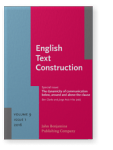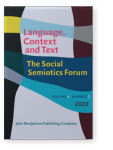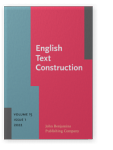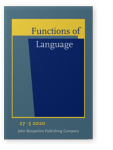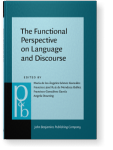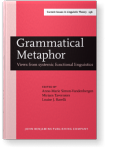Jorge Arús-Hita
List of John Benjamins publications for which Jorge Arús-Hita plays a role.
Journal
Title
The dynamicity of communication below, around and above the clause
Edited by Ben Clarke and Jorge Arús-Hita
Special issue of English Text Construction 9:1 (2016) v, 219 pp.
Subjects Applied linguistics | English linguistics | English literature & literary studies | Theoretical literature & literary studies
2024 The intricate construction of projection in news reports: A contrastive English/Spanish account Languages in Contrast: Online-First Articles | Article
This paper looks at projection in the discourse of news reports in English and Spanish. The analysis reveals the extent to which projection pervades these texts, not only at clause complex level – the traditional object of study of projection – but also below the clause complex, at clause simple… read more
2022 Theme as point of departure in English and Spanish casual conversation: A contrastive study Language, Context and Text 4:2, pp. 197–226 | Article
This paper uses a trinocular approach – i.e. from below, from above and from roundabout – to describe Theme as point of departure (POD) in English and Spanish casual conversation (thus avoiding the more controversial ‘what-the-clause-is-about’ aspect of Theme). This research is part of a… read more
2022 A contrastive look at Theme as point of departure in English and Spanish academic writing English Text Construction 15:1, pp. 1–29 | Article
This paper offers a detailed study of Theme as point of departure in English and Spanish academic texts. A corpus of around 45,000 words is examined from different perspectives to compare the realizations, functions and interplays of the point of departure in these two languages. Examples reveal… read more
2020 Give as a light verb Functions of Language 27:3, pp. 280–306 | Article
Light Verb Constructions (LVCs) have received widespread attention. Research on these constructions, however, has for the most part focused exclusively on their syntactic and lexical-semantic properties. Additionally, studies devoted to specific LVCs tend to neglect the phrasal-semantic and… read more
2016 The dynamicity of communication below, around and above the clause: Introduction The dynamicity of communication below, around and above the clause, Clarke, Ben and Jorge Arús-Hita (eds.), pp. 1–8 | Article
2014 Contrastive corpus annotation in the CONTRANOT project: Issues and problems The Functional Perspective on Language and Discourse: Applications and implications, Gómez González, María de los Ángeles, Francisco José Ruiz de Mendoza Ibáñez, Francisco Gonzálvez-García and Angela Downing (eds.), pp. 57–86 | Article
In this paper we outline a number of issues and problems which arise during
the process of contrastive human-coded corpus annotation of certain semantic
and discourse categories within the framework of the CONTRANOT project,
aimed at the creation and validation of contrastive functional… read more
2013 Thematic variation in English and Spanish newspaper genres: A contrastive corpus-based study Advances in Corpus-based Contrastive Linguistics: Studies in honour of Stig Johansson, Aijmer, Karin and Bengt Altenberg (eds.), pp. 261–286 | Article
This paper describes the thematic variation observed in two newspaper genres – news reports and commentaries – in English and Spanish and studies the influence of genre-specific and language-specific constraints on the observed variation. The study is based on the contrastive analysis of certain… read more
2004 Nuclear transitivity in English and Spanish: A contrastive functional study Functional Linguistics and Contrastive Description, Davidse, Kristin and Liesbet Heyvaert (eds.), pp. 75–103 | Article
This paper presents a contrastive overview of nuclear transitivity in English and Spanish from a systemic-functional perspective. The study attempts to achieve two main goals. Firstly, we investigate the usefulness of the transitive/ergative distinction developed by Davidse (1992) for material… read more
2003 Ambiguity in grammatical metaphor: One more reason why the distinction transitive/ergative pays off Grammatical Metaphor: Views from systemic functional linguistics, Simon-Vandenbergen, Anne-Marie, Miriam Taverniers and Louise J. Ravelli (eds.), pp. 101–126 | Article

